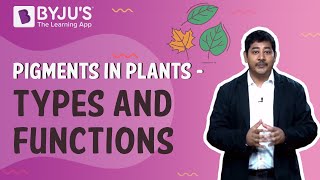Chlorophyll
The word chlorophyll is derived from the Greek word khloros (green) and phyllon (leaves). Chlorophyll is a green pigment that acts as a photoreceptor. It is a pigment that perceives light energy and aids in the biochemical process. This exists in many forms, such as chlorophyll a, chlorophyll b, etc. Also, chlorophyll is one of the pigments that aid in the photosynthesis process.
The chlorophyll absorbs light energy of red and blue wavelengths. Whereas, the green light is not absorbed and is reflected back. Thus, the leaves appear green.
Type of Chlorophyll
Chlorophyll a
This pigment is found in all higher plants. It is the most vital pigment used in photosynthesis. Some algae, cyanobacteria and anaerobic phototrophs also show the presence of chlorophyll a. It has a strong rate of absorption. It absorbs violet-blue as well as orange-red light and reflects blue-green light.
Chlorophyll b
This type of chlorophyll is seen in green algae and plants. It is an accessory pigment that aids chlorophyll a. This pigment usually absorbs the orange-red light and reflects a yellow-green colour. The chlorin ring of this chlorophyll has a CHO. Whereas, the chlorin ring of Chlorophyll-a contains CH3
Also Read: Difference between chlorophyll a and chlorophyll b
Chlorophyll c
This pigment is primarily seen in marine algae. Brown algae, Diatoms and Dinoflagellates show the presence of chlorophyll c. It is an unusual chlorophyll pigment that has a porphyrin ring. This can be further classified into chlorophyll c1, c2 and c3. The chemical composition and the absorption rate differ in each sub-type.
Chlorophyll d
Chlorophyll d is present only in red algae and cyanobacteria. These organisms live in deep water, and thus use red light for photosynthesis.
Chlorophyll e
This is a rare pigment that is found in some golden algae. Chlorophyll e has been identified from the Xanthophytes (yellow-green algae).
Chlorophyll f
This pigment was recently found and is known to absorb infrared light. It can absorb light of a wavelength that is over the visible range. Their function is yet to be studied.
Frequently Asked Questions
What are the other biological pigments that help in photosynthesis?
The photosynthesis process is mainly based on chlorophyll pigment. Also, there are other red and yellow pigments that help in this biological process. This includes carotenoids (yellow-orange), xanthophylls (yellow), and betalain (red) pigments.
Extended Reading: Biological Pigments in Plants
What is Chloroplast?
The chlorophyll pigment is found in plant cells’ chloroplasts. These chloroplasts act as a site of the photosynthesis process in plants. Usually, the chloroplasts align along the walls of the mesophyll. This helps them to receive optimum sunlight. The chloroplast has different membranes like grana, stroma, lamella and thylakoids. The chlorophyll pigment is enclosed in the thylakoids of the chloroplast.
More to Read: Difference between Chlorophyll and Chloroplast
Keep exploring BYJU’S Biology for more exciting topics.



Comments